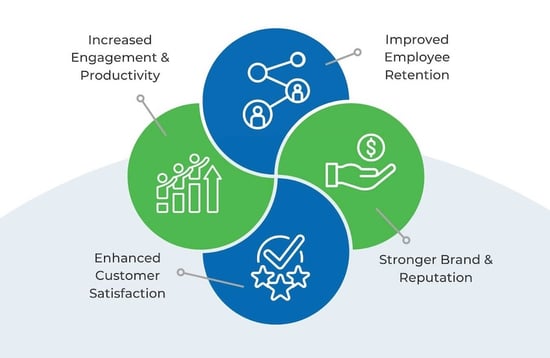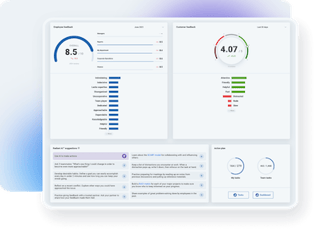
The Future of Employee Experience: Navigating the Shifting Landscape in 2024
What happened to the employee experience in 2023, and do we see additional shifts in 2024?
Navigating the ever-evolving landscape of employee experience (EX) is no small feat, especially after a year like 2023. As the CEO and founder of Macorva, a company at the forefront of harnessing AI to enhance both employee and customer feedback, I've witnessed firsthand the seismic shifts in the workplace. With a finger on the pulse of the latest EX and CX trends, I've gathered some of the top events and trends that impacted the last year and the world of EX. Keep reading to see how these insights can help us anticipate and shape the future of work as we move into 2024 and beyond.
The power of employee experience on business outcomes

-
The McKinsey Global Institute's "The Future of Work After COVID-19"
-
The World Economic Forum's "Future of Jobs Report 2023"
In short, they predict that AI, machine learning, and offshoots of these advanced technologies will merge with big data (i.e., data analytics) to create transparency in new markets - significantly altering the workplace. They underline that employees will adapt to relegating repetitive, admin-related tasks to robotic software functions (or, unfortunately, become redundant). On the other hand, fast responders will self-actualize by participating in strategic and creative business situations - within innovative hybrid work models - requiring human brain power to make a meaningful difference. It sets the stage for a more digitized, inclusive, and flexible work environment, with employee well-being as a front-and-center priority.
These reports predict the emergence of progressive tech- and data-driven changes. Simultaneously, they'll bolster employee work-life balance, increase productivity, encourage innovation, and reward creativity. Our experience at Macorva - as we have seen with clients of our AI-powered software - is that these initiatives accelerate employee engagement, performance development, and job satisfaction - the essential ingredients of a robust EX. Of course, it won't be plain sailing in a rollicking sea of uncertainty, but for those with resilience, adaptability, and open-mindedness, 2024 will be an excellent year.
Trends to watch in 2024
1. AI work-enablement
ChatGPT hit the work landscape with a bang as we entered 2023, opening the eyes of everyone to the fantastic transformational opportunities generative artificial intelligence offers, as follows:
- Firstly, AI is at the forefront of repetitive task automation, allowing employees to follow paths that significantly enhance job satisfaction. However, it will only motivate those without fear of change, ready to accept reskilling and upskilling programs, to align themselves with new job demands (notable sub-trends under the AI heading).
- Secondly, as AI connects to data analytics, it creates mind-boggling insights multiple times faster than teams of humans could ever achieve. Indeed, it demonstrates the power to revolutionize decision-making processes and accuracy.
- Lastly, AI is shaping up to create personalized training and development programs that resonate with every worker committing to the adjustment process, assuring them of adhering to strict privacy standards and fitting in neatly with almost every corporate infrastructure.
Soliciting employee support and commitment to AI initiatives is crucial to success, dictating much of the progress and its ultimate impact on one's strategic approach. Unfortunately, "emotional" issues will likely disrupt team harmony as the inevitable AI technologies impact operations. How so? While AI and ML promise exceptional human resource rewards to employees willing to venture into new horizons, those unable or resisting constructive hybrid models, new work schedules, and adjusting to elevated stakeholder expectations will likely obstruct progress before falling by the wayside.
2. A galloping digital employee experience
Practical digital employee experiences are shaping into a fundamental part of 2024 business planning. Undoubtedly, digital infrastructures have advanced considerably in 2023, but there's a significant way to go in 2024 and the years following. The priority will be integrating new and advanced Apps and SaaS tools (much of it AI-driven - see above) into company operations, which involves three primary considerations:
- Settling on the most suitable digital design model for the business
- Dealing with analytics and feedback loops
- Deciding on the optimal hybrid work balance
However, the challenge of structuring a digital framework firing on all cylinders is anything but straightforward. For example, what if there are no “in-house” IT resources? SMB entities fall squarely into the latter category, primarily contracting outside services. No matter what, the main goals and tasks come down to three key activities:
a. Bringing users into the process, encouraging them to engage with platforms and dashboards that are intuitively functional.
b. Aligning with fast learning formats that represent visible and rewarding results.
c. Addressing poorly conceived configurations - the source of worker frustration, productivity implosions, and ultimately employee churn.
d. Testing each step in the process against user-adoption speed, job satisfaction, team engagement, and promoting a productive environment.
e. Assessing the impact on the employee experience (leading to CX upliftment) via innovative journey mapping techniques.
2. Feedback loops from data analytics are dependent on:
a. Accumulating vast data volumes
b. Data engineering skills to:
- Navigate the processes
- Assess raw information quality
- Define the data fields in terms of quality and usefulness
- Refine exercises to align precisely with corporate strategic objectives
3. Covering hybrid work model needs with the appropriate digital tools for the remote work side of things, such as:
b. Elevating home operations to the in-office work standards with similar support protocols.
c. Creating remote collaboration, project management, and social interaction features that align with virtual and in-office interaction in a balanced way.
3. A favorable CX depends on an equally good EX
While AI and chatbots will be a massive focus in 2024, businesses intent on meeting every customer touchpoint with an acceptable degree of satisfaction will insert a human element. Why? Complex CX issues won't disappear, so only competent employee interaction can restore brand trust and confidence if and when they raise their ugly heads. It requires a sense of empathy and training to deal with the sometimes unique situations presented by customers. The findings speak for themselves. Businesses that allow customers to interact with disengaged and dissatisfied employees will inevitably degrade CX and feed the churn factor.
Staying on the pulse of employee performance with actionable steps for improvement will be increasingly important for effective CX strategies in 2024 and beyond.
Studies in 2022 show that one negative customer/service agent interaction is all it takes to derail a customer journey - a scary notion. It cites the following insights:
- Business representatives severely disappointed 66% of customers with inferior service on many levels.
- On several occasions, 33% of customers confessed to short-temper outbursts with brand agents.
Another Harvard Business Review report (on a global retail brand research program) underlined that customer-facing employees have the power to significantly impact revenue in both directions. Interestingly, it shows that moderately improving a few fundamental EX KPIs gives sales an outsized boost without adding to overheads. Reinforcing the viewpoint above, the report supports that there’s no doubt customers will connect to brands when they sense employee enthusiasm and belief in their benefits and claims.
Emphasizing this further, is the competitive environment that is expected to intensify. As a result, it'll threaten long-term client loyalty, the most threatening being sub-par treatment by support agents, store personnel, and untrained sales representatives. It won't take much for a customer base the stakeholders take for granted as stable to jump ship when disruptive competitors offer meaningful differences.
Undoubtedly, most companies understand that unhappy, unengaged employees will be toxic additions to the team in the future (i.e., 2024 and forever). It has resulted in zero tolerance for anyone in the business who corrupts its value proposition directly or indirectly, culminating in a poor CX. But there is a solution. AI-powered EX platforms like Macorva offer precision AI resources that fit in here like a hand in a glove by connecting employees to the customer journey to identify and erase defective touchpoints. Out technology is also in sync with matching KPI monitoring programs to EX in any business.
Conclusion
As we come to the end of our journey through the twists and turns of 2023, it's clear that the road ahead in 2024 is all about agility and connection. The challenges businesses face in the realm of employee experience (EX) are as diverse as they are complex, but they also open doors to new opportunities for growth and innovation.
With the right approach, organizations can build a resilient, responsive, and thriving workplace that not only meets the challenges of 2024 but also sets a new standard for excellence in the employee experience.
At Macorva, we understand that the key to navigating these changes lies in staying attuned to the heartbeat of our organizations—our people. Our platform is designed to seamlessly integrate into the daily workflow, providing real-time insights that empower leaders to make informed decisions and foster a culture of engagement and retention. Here are some helpful resources to learn more about how Macorva can enhance your EX strategy:








